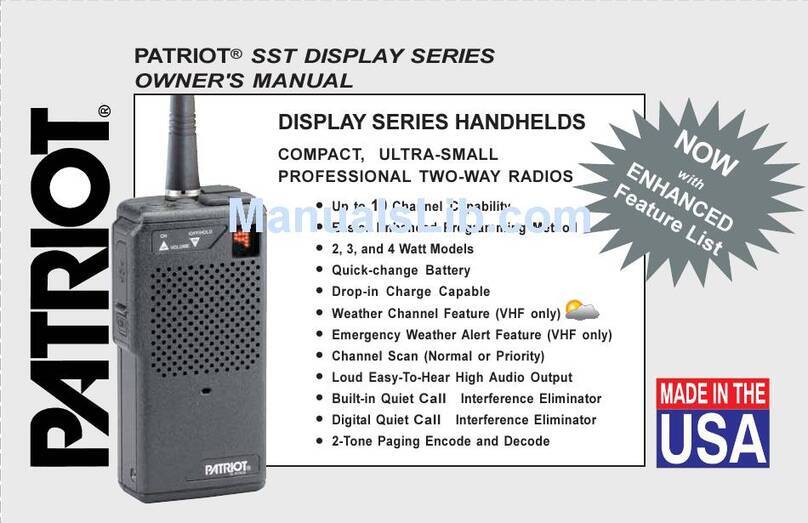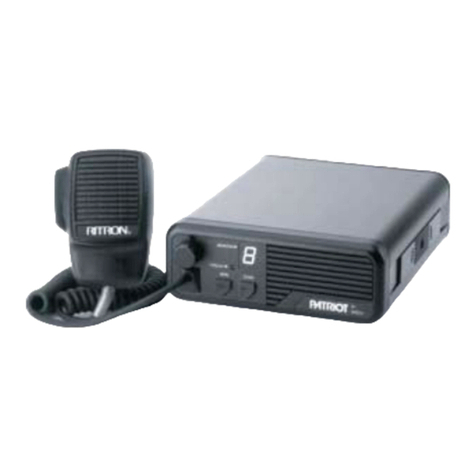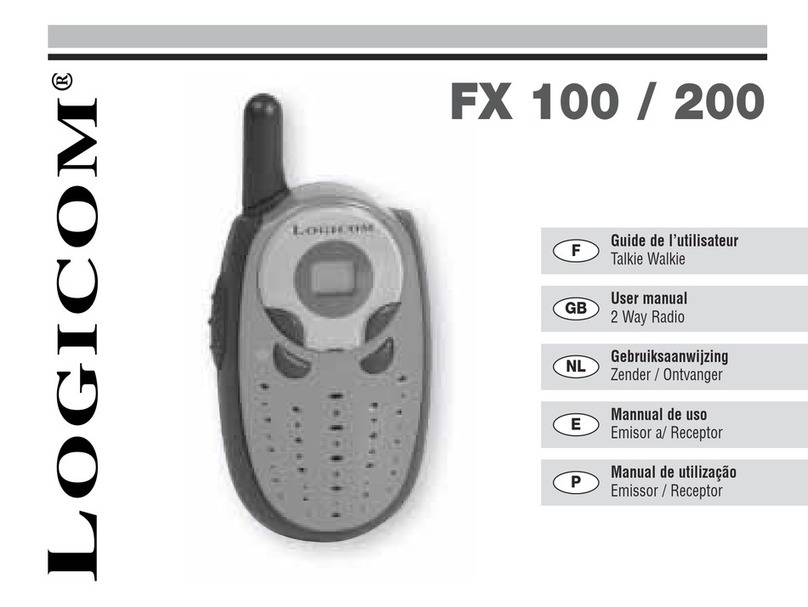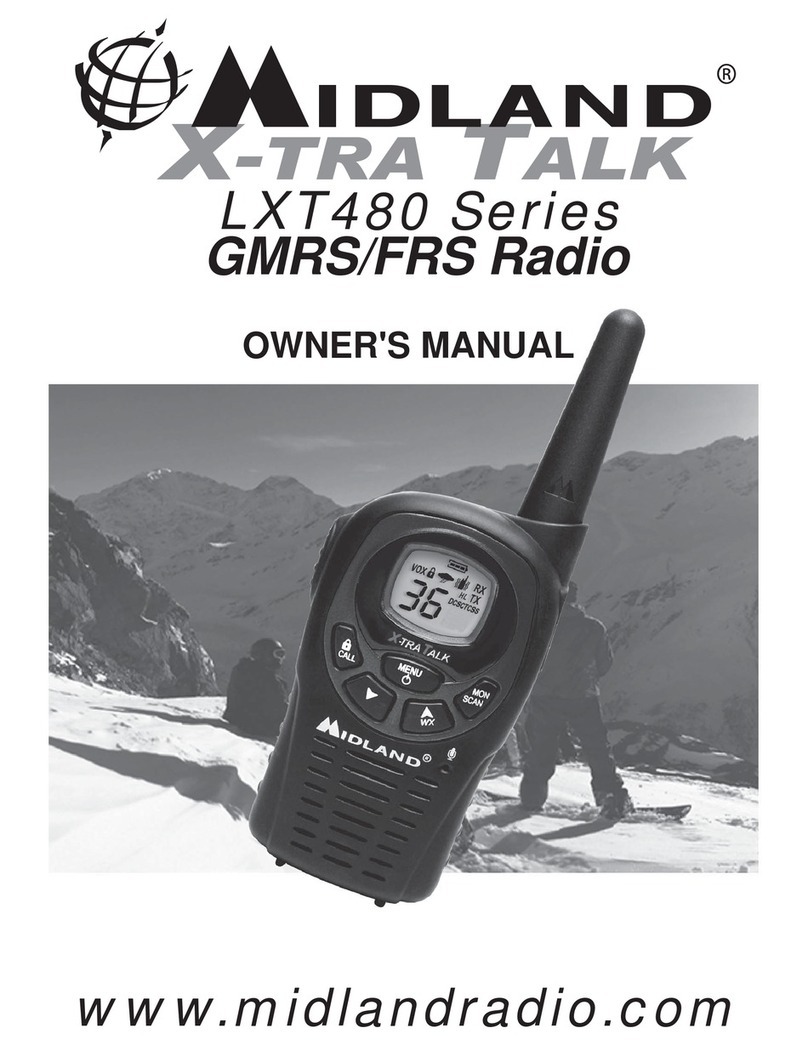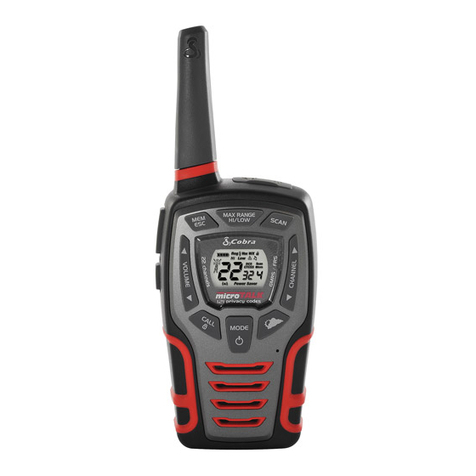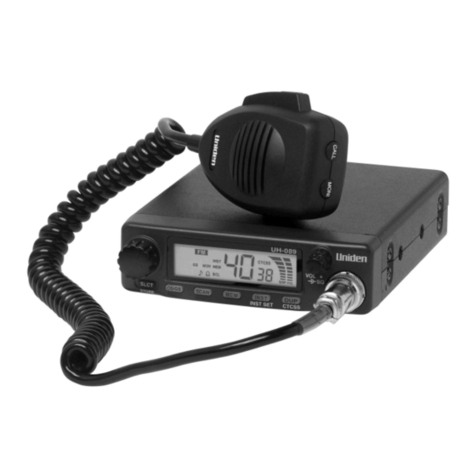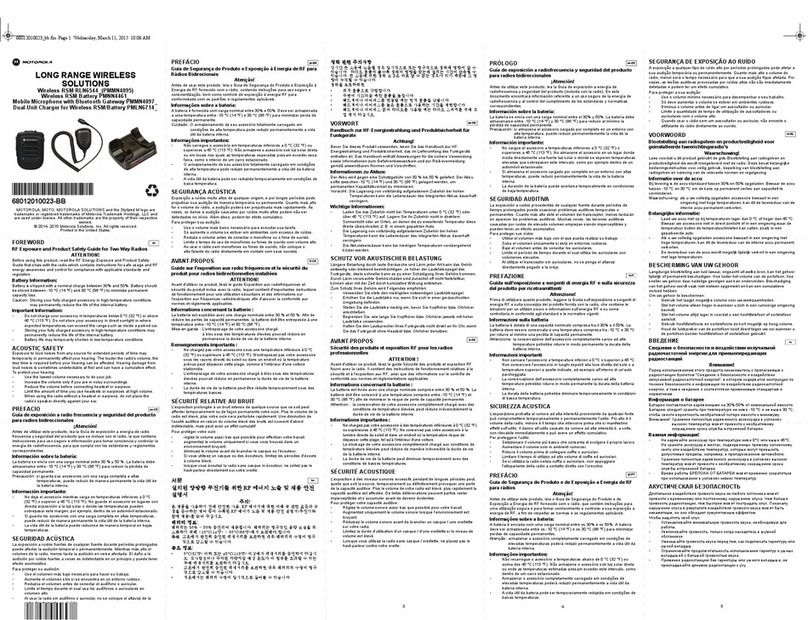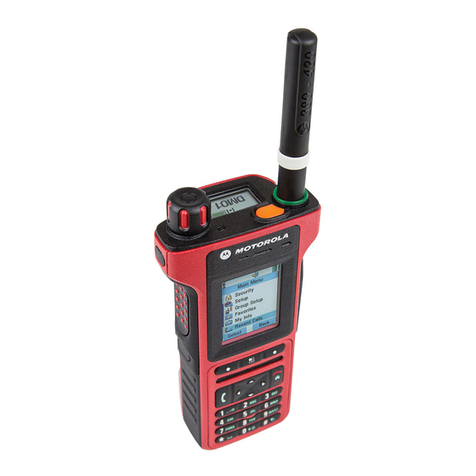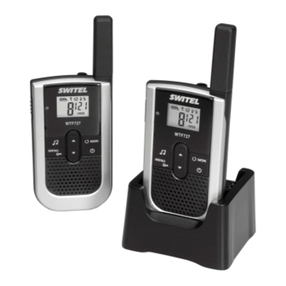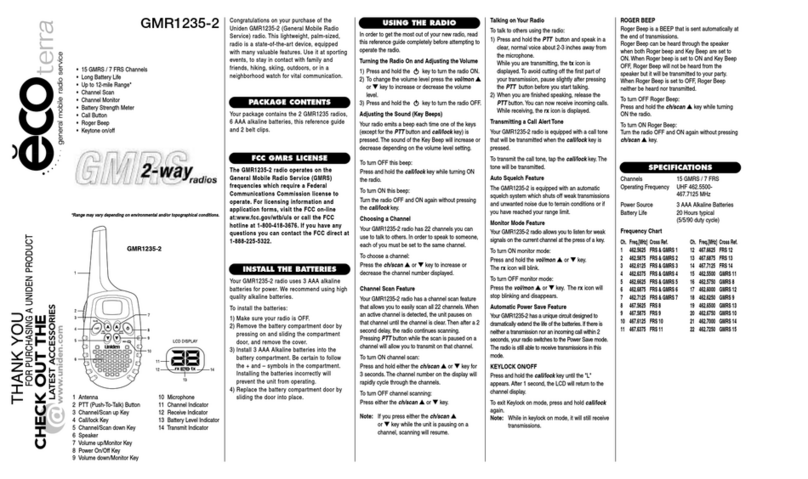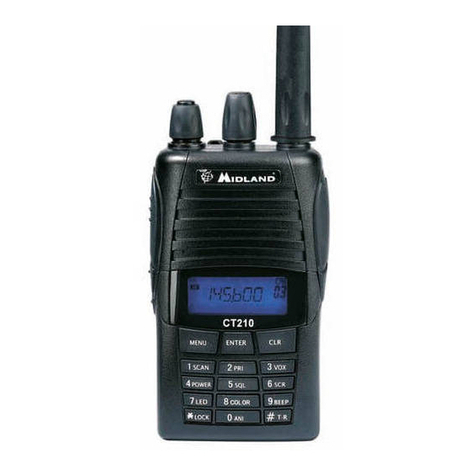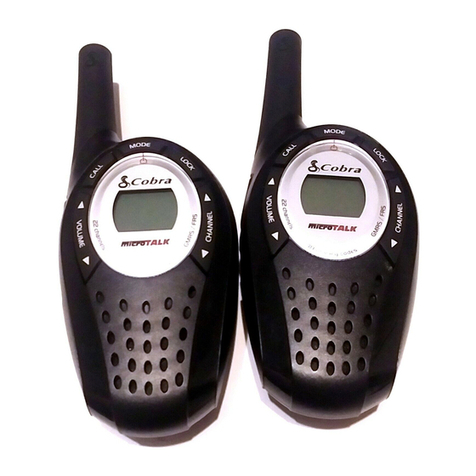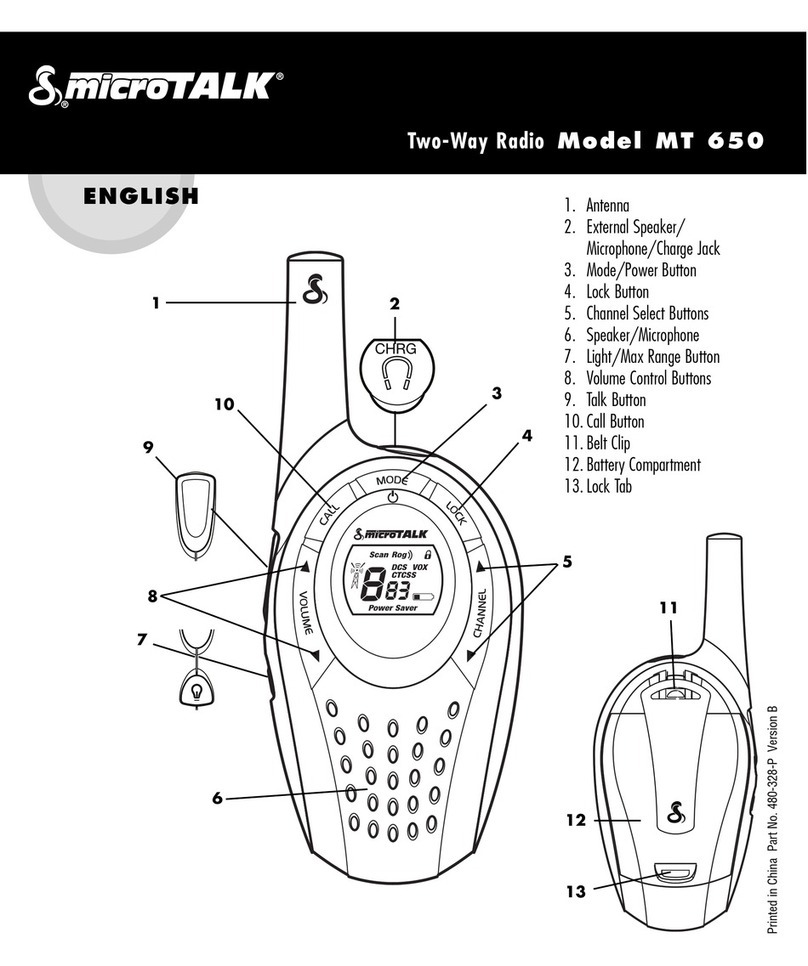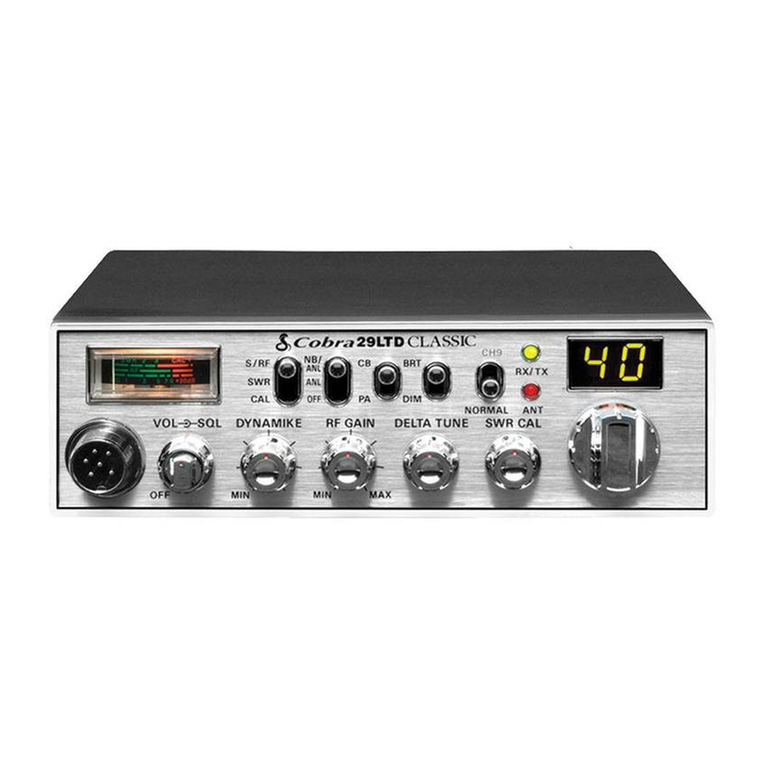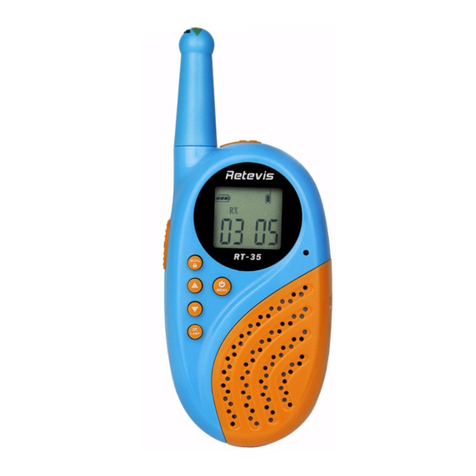Patriot RITRON SST-442 Operating and maintenance manual

TYPE OF EXHIBIT: INSTRUCTION MANUALS
FCC PART: 2.1033 (c)(3)
MANUFACTURER: RITRON, INC.
505 West Carmel Drive
Carmel, IN 46032
MODEL:SST-442
TYPE OF UNIT: UHF-FM Handheld Transceiver
FCC ID: AIERIT13-442
DATE:May 11, 2001
Included in this exhibit is a draft of the Maintenance and Operating Manual for RITRON Model Patriot
SST-442UHF-FM Handheld Transceiver.
Specifically, this manual includes a technical description of the SST-442sufficient to establish compliance
with the technical standards of the applicable rule part(s).
This includes, but is not limited to, the following items required under FCC Part 2.1033 (c):
(2) FCC Identifier.
(3) A copy of the installation and operating instructions.
(4) Type of emission.
(5) Frequency range.
(6) Range of operating power, and means to provide variation in operating power.
(7) Maximum power rating.
(8) DC voltage chart.
(9) Tune-up procedure.
(10) A description of all frequency determining and stabilization circuits. A description of the circuits
used to suppress spurious radiation, limiting modulation, and limiting power.
(12) Drawing with labels for controls and complete circuit diagrams.
Signed: Michael A. Pickard - Project Engineer

TWO-WAY RADIO BY RITRON
RITRON MODEL SST-442
UHF FMBAND PROGRAMMABLE HANDHELD RADIO
MAINTENANCE / REPAIR / OPERATING MANUAL
FOR USE BY AUTHORIZED SERVICE/MAINTENANCE PERSONNEL ONLY
SST-442-MRMREVA
COPYRIGHT2001 RITRON, INC. •ALL RIGHTS RESERVED
RITRON, JOBCOM, and QUIET CALL, ARE REGISTERED TRADEMARKS OF RITRON, INC.

TABLE OF CONTENTS SST-442
TOPIC PAGE
IMPORTANT MAINTENANCE/REPAIR INFORMATION..1
SPECIFICATIONS
GENERAL......................................................................... 2
CONTROLS ...................................................................... 2
TRANSMITTER................................................................. 2
RECEIVER........................................................................ 3
BATTERY ......................................................................... 3
INTRODUCTION
GENERAL......................................................................... 4
Model Identification ..................................................... 4
FCC REGULATIONS
Licensing..................................................................... 4
Safety Standards......................................................... 4
BATTERY CARE
CHARGING....................................................................... 5
PRECAUTIONS ................................................................ 5
BATTERY REPLACEMENT.............................................. 5
Fig. 1 Battery Replacement......................................... 5
BATTERY MAINTENANCE............................................... 6
BATTERY CONDITIONING .............................................. 6
OPERATION
DESCRIPTION OF CONTROLS AND CONNECTORS..... 7
Fig. 2 Controls and Accessory Connectors.................. 7
RADIO OPERATION
On-Off/Volume ............................................................ 8
Receive....................................................................... 8
Selective Signaling Squelch ........................................ 8
Monitor........................................................................ 8
Battery Saver .............................................................. 8
Transmit...................................................................... 8
Channel Selection ....................................................... 8
WHAT THE RADIO TONES MEAN
Power On/Self Check “OK........................................... 9
Error Tones ................................................................. 9
Channel Select............................................................ 9
Tone Squelch.............................................................. 9
Recharge Battery Alert ................................................ 9
OPTIONAL RADIO TONES
Receiver Squelch Tone ............................................... 9
Busy Channel Inhibit ................................................... 9
Transmitter Time Out .................................................. 9
BELT CLIP INSTALLATION.............................................. 9
TROUBLESHOOTING
General ..................................................................... 10
Battery ...................................................................... 10
Error Tones ............................................................... 10
Tone Coded Squelch................................................. 10
PROGRAMMING THERADIO
PTT (PUSH-TO-TALK) PROGRAMMING
Fig. 3 Placing the Radio in Program / Readout Mode 11
Reading Out a Radio Channel’s Content................... 11
PTT Programming the Radio..................................... 12
Return To Normal Operation ..................................... 12
PTT Programming Mistakes...................................... 12
Table 1 – PTT Programming Frequency Table.......... 13
Table 2 – Quiet Call Codes and Frequencies ............ 13
COMPUTER SOFTWARE COPYRIGHTS ...................... 13
PC COMPUTER PROGRAMMING ................................. 13
Programmable Features............................................ 14
Description of Features ............................................. 15
TOPIC PAGE
THEORYOFOPERATION
INTRODUCTION .............................................................16
POWER SUPPLY AND VOLTAGE DISTRIBUTION........ 16
Power Strobe............................................................. 16
Low Battery Voltage Detection...................................16
REFERENCE OSCILLATOR ........................................... 16
SYNTHESIZER ..............................................................16
Pin Numbers.............................................................. 16
Prescaler Divider / Synthesizer Controller..................16
VCO / Buffer Amplifiers .............................................17
Oscillator Modulation .................................................17
DIGITAL POTENTIOMETERS......................................... 17
RECEIVER ......................................................................17
RF Amplifier...............................................................17
1st Mixer....................................................................18
FM Receiver Subsystem............................................ 18
Voice / Tone Conditioning in Receiver Mode .............18
Voice Band ................................................................18
Sub-Audible............................................................... 18
Audio Amplifier ..........................................................18
ANTENNA SWITCHING / LOW-PASS FILTER............... 19
TRANSMITTER ............................................................... 19
Keying .......................................................................19
+VTX Supply..............................................................19
Power Amplifier .........................................................19
Voice/Tone Conditioning in Transmit Mode ...............19
Voice Band ................................................................19
Sub-Audible............................................................... 19
MICROCONTROLLER ....................................................20
ALIGNMENTPROCEDURE
RECOMMENDED TEST EQUIPMENT............................21
RADIO PREPARATION...................................................21
REFERENCE FREQUENCY ...........................................21
MODULATION BALANCE ...............................................22
TRANSMITTER TONE DEVIATION ................................22
TRANSMITTER VOICE DEVIATION............................... 22
RECEIVER SENSITIVITY AND SQUELCH.....................22
RECEIVER NOISE SQUELCH ........................................23
SYNTHESIZER ...............................................................23
VOLTAGE CHART
Measurement Conditions................................................. 24
SST-442 Voltages ........................................................... 24
PARTS LIST
SCHEMATIC REFERENCE PARTS LIST .......................27
CASE ASSEMBLY PARTS LIST .....................................33
SCHEMATIC AND PART PLACEMENT DRAWINGS
TOP SIDE PART PLACEMENT.......................................35
BOTTOM SIDE PART PLACEMENT...............................36
SCHEMATIC – UHF RF ..................................................37
SCHEMATIC – Signal Processing ................................... 38

IMPORTANT REPAIR / MAINTENANCE INFORMATION SST-442
1
Surface Mount Repair
RITRON surface mount products require special
equipment and servicing techniques. Improper
servicing techniques can cause permanent damage
to the printed circuit boards and/or components,
which is not covered by RITRON’s warranty. If you
are not completely familiar with surface mounted
component repair techniques, RITRON recommends
that you defer maintenance to qualified service
personnel.
Precautions for Handling CMOSDevices
This radio contains complementary metal-oxide
semiconductor (CMOS) devices, which require
special handling techniques. CMOS circuits are
susceptible to damage by electrostatic or high voltage
charges. Damage can be latent, with no failure
appearing until weeks or months later. For this
reason, take special precautions any time you
disassemble the radio. Follow the precautions below,
which are even more critical in low humidity
environments.
1) Storage/transport - CMOS devices that will be
stored or transported must be placed in
conductive material so that all exposed leads are
shorted together. CMOS devices must not be
inserted into conventional plastic “snow” or
plastic trays of the type that are used for other
semiconductors.
2) Grounding - All CMOS devices must be placed
on a grounded bench surface. The technician
that will work on the radio/CMOS circuit must be
grounded before handling the radio. Normally,
the technician wears a conductive wrist strap in
series with a 100K Ohm resistor to ground.
3) Clothing - Do not wear nylon clothing while
handling CMOS circuits.
4) Power off - Remove power before connecting,
removing or soldering a PC board that contains
CMOS devices.
5) Power/voltage transients - Do not insert or
remove CMOS devices with power applied.
Check all power supplies to be used for testing
CMOS devices, making sure that no voltage
transients are present.
6) Soldering - Use a grounded soldering iron for
soldering CMOS circuitry.
7) Lead-straightening tools - When straightening
CMOS leads, provide ground straps for the tool
used.
PC Board Removal - Special Tool
RITRON recommends using a knurled nut tool to
remove the slotted knurled nuts that secure the
charge and audio jacks on top of the radio. You will
need two sizes of this tool, one for each jack size.
Mouser Corporation is one source, stock number
382-0004 (2.5mm jack) and 382-0006 (3.5mm jack).
You can reach Mouser sales and distribution center
at 1-800-346-6873.
Properly Attach the Synthesizer Shield
The synthesizer shield should not be removed, unless
a component must be replaced. This shield is
soldered to the main PC board.
Re-assembly - Speaker Magnet, BatteryVoltage
on Connector Pin
The speaker magnet will pick up clipped leads and
other small metal objects from your bench top. Even
tiny objects on the diaphragm will cause the speaker
to buzz. Make sure the speaker is free of foreign
objects before reassembling the radio.
Radio Transmitter Power Measurements
The SST-442 was designed to produce 2 Watts of
Transmitter power at nominal battery voltage (+7.2
VDC), throughout the radio’s operating frequency
range. Measurements are made with the RITRON
SST-SRVBD RF service module connected to the
radio antenna terminal. The transmitter was
designed with close tolerances to prevent RF power
output from exceeding specifications and reducing
battery life.
PCB and Firmware Revisions
Changes in circuit design, component values, and
radio firmware are made occasionally to enhance the
performance of the SST-442. In general, the manual
will be periodically updated for component value
changes without a change in the manual revision
level. Always refer to the Schematic Reference Parts
List for the most recent component values. Changes
in circuit design that require printed circuit board
revision, or changes in firmware that significantly alter
the operating characteristics of the radio, will be
covered in a revised manual.
This manual is updated for the following revisions:
SST-442-MRM Rev A
PCB Revision 1750270A
Firmware Revision v06

SPECIFICATIONS SST-442
2
GENERAL
FCC ID: AIERIT13-442
FCC Rule Parts: 22, 74, 90, 95
Frequency Range: 450 to 470 MHz
Max. Freq. Separation: 10 MHz
RF Channels: Up to 10 Channels,
Independent TX/RX
frequencies.
Synthesizer Step Size: 12.5 KHz
Frequency Stability: +/-2.5 PPM (-30 to +60 C)
TX/RX
Tone/Code Signaling: CTCSS (Quiet Call)
Digital Coded Squelch
(Digital Quiet Call)
Dimensions: 4.75”H x 2.2”W x 1.43”D
Weight: 11.5 oz. with battery pack
Enclosure Material: Lexan Polycarbonate
Environmental: Splash resistant and
shock and vibration per
RITRON Drop Test (6 ft.
drop onto concrete on all
six sides)
Antenna Fitting: 1/4" - 32 x 1/4" threaded
External RF Test Jack: Antenna connector with
RITRON SST-SRVBD test
device
Earphone Jack: 3.5 mm, disconnects the
internal speaker for
external earphone,
speaker / microphone, or
headset. Also provides
cable connection for PC
programming.
Microphone/PTT/ 2.5 mm, for external
Chg Jack: speaker/microphone,
headset or RITRON model
BC-A wall charger.
CONTROLS
Push Button Controls: On/Volume Up, Volume
Down/Off, PTT, Channel
Speaker Beep Indicators:
On/Volume Up: Radio beeps channel
number when turned on,
followed by increasing
audio to adjust volume.
Volume Down/Off: Decreasing audio to adjust
volume, with two tones
when turned off.
Both Volume Buttons: Alternates between Tone
Squelch (single beep) and
Carrier Squelch (two
beeps). If both buttons
are held down until the
radio beeps repeatedly,
squelch will be disabled.
PTT: Programmable for a single
“transmit beep”.
Channel: Number of beeps indicates
channel.
TRANSMITTER
RF Power Output: 2 Watts @ +7.2 VDC
Wide Mode Narrow Mode
Emission Designator: 16K0F3E 11K0F3E
Deviation: +/- 5.00 KHz +/- 2.50 KHz
FM Hum and Noise: -43 dB -37 dB
Audio Distortion:<3%
Spurious & Harmonics: -50 dBc
Audio Response: Meets FCC and EIA
requirements
Time-out Timer: 60 seconds,
programmable

SPECIFICATIONS SST-442
3
RECEIVER
Wide band Narrow band
Models Models
Modulation Acceptance: +/- 7.0 KHz +/- 3.75 KHz
Sensitivity: 0.25 µV 0.25 µV
(12 dB SINAD)
Adjacent Channel (EIA): -60 dB -50 dB
Spurious Rejection: -60 dB -60 dB
Image Rejection (EIA): -70 dB -70 dB
Intermodulation (EIA): -56 dB -57 dB
Noise Squelch Programmable per
Sensitivity: channel, factory set for 12
dB SINAD
Frequency Response: 300 - 3000 Hz, de-
emphasized
Audio Output 1 Watt into 8 Ω, with less
than 5 % THD @ the
earphone jack
Receiving System: Dual conversion
superheterodyne
I.F. System: 1st - 43.65 MHz,
2nd - 450 KHz
L.O. Injection: Low side
QC/DQC Decode Time: per EIA Standards
BATTERY
Battery Pack: +7.2 VDC, 800 mAH
rechargeable NiCd battery
pack standard
+7.2 VDC, 1500 mAH
rechargeable MiMH
battery pack optional
Battery Drain:
Standby: 52 mA
Sleep: 12 mA
Avg. Standby
with Power Saver: 24 mA
Receive: 125 mA
Transmit: 850 mA @ 2 Watts
Battery Life @ 90/5/5 Duty Cycle with
Standard battery pack (800 mAH):
12.7 Hrs, Battery Saver On
8.4 Hrs, Battery Saver Off
Battery Life @ 90/5/5 Duty Cycle with
High capacity battery pack (1500 mAH):
23.7 Hrs, Battery Saver On
15.7 Hrs, Battery Saver Off

INTRODUCTION SST-442
4
GENERAL
RITRON's SST-442 handheld is a small,
programmable two-way radio, designed to operate in
the 450-470 MHz professional FM communications
band. This handheld features push-button operating
controls, with the Push-To-Talk and Channel buttons
on one side of the radio. The On / Volume Up and
Volume Down / Off, volume and monitor controls are
on top.
Each radio can be “dealer” programmed to contain a
unique set of operating frequencies and options.
Selective signaling options include Quiet Call
(CTCSS) and Digital Quiet Call (DCS). Transmitter
power, operating bandwidth and battery saver are
among the options programmable on a per channel
basis.
Model Identification
The SST-442 model, serial number and FCC
Identification are displayed on a label located on the
back of the radio beneath the belt clip.
FCC REGULATIONS
Licensing
The FCC requires the radio owner to obtain a station
license for his radios before using them to transmit,
but does not require an operating license or permit.
The station licensee is responsible for ensuring that
transmitter power; frequency and deviation are within
the limits specified by the station license. The station
licensee is also responsible for proper operation and
maintenance of the radio equipment. This includes
checking the transmitter frequency and deviation
periodically, using appropriate methods.
Safety Standards
In 1991 the Institute of Electrical and Electronics
Engineers (IEEE), and in 1992 the American National
Standards Institute (ANSI) updated the 1982 ANSI
standard for safety levels with respect to human
exposure to RF energy. Over 120 scientists,
engineers, and physicians from universities,
government health agencies, and industry, after
reviewing the available body of research, developed
this updated Standard. In March 1993 the Federal
Communications Commission (FCC) proposed the
adoption of this updated Standard.
The SST-442 handheld radio is designed to comply
with this Standard. To limit your exposure to levels
at, or below, the levels in the Standard, please
observe the following:
•Use only the antenna(s) available from RITRON
for this model. DO NOT attempt to substitute any
other antenna.
•Keep talk times as short and infrequent as
possible. DO NOT depress the PTT button when
not actually wishing to transmit. The radio is
equipped with an internal timer to limit continuous
transmit times.
•When transmitting, hold the radio in front of the
mouth at a distance of at least 4 inches. DO NOT
hold the radio in such a manner that the antenna
is next to, or touching, exposed parts of the body,
especially the face or eyes while transmitting.
•In belt mounted applications, when transmitting,
remove the radio from the belt and hold away from
the body at least 4 inches.
•When using external headset accessories, hold
the unit away from the body at least 4 inches while
transmitting.
•DO NOT allow children to operate the radio.

BATTERY CARE SST-442
5
CHARGING
The handheld is powered by a rechargeable battery,
which fits into the radio case (see FIG-1).
The battery pack can lose its charge during storage
and shipment, and should be fully charged before the
radio is used. Thereafter, the battery should be
charged overnight after each day of use, to ensure
peak radio performance for the next day. Using the
cube charger (model BC-A), the battery should
charge completely in 12 hours.
To charge the battery using a RITRON cube charger -
plug the charger cord into the smaller of the two jacks
on top of the radio. Then plug the cube into a 110
VAC outlet. The green lamp lights while the battery is
charging, and should go off only when the cube is
unplugged.
Two charger contacts, visible through the bottom of
the radio case, allow the battery to be charged using
an optional RITRON drop-in charger (model BCC-
PS). The battery pack may be charged inside or
outside of the radio case.
To charge the battery using a drop-in charger (model
BCC-PS) - plug the drop-in charger into a 110 VAC
outlet. Set the portable or battery into the charger.
Each battery contact must rest on a charger contact
pin.
NOTE: A new battery must be cycled (charged and
discharged) several times before it will reach
its maximum charge capacity.
PRECAUTIONS
•Use only RITRON-supplied chargers; other
chargers might cause fire, explosion, or other
damage to the radio.
•Do not "fast-charge" a brand new battery pack.
Otherwise, the battery might be damaged.
•Once the battery has been charged fully using
the normal rate, the fast rate may be used
thereafter.
•Do not fast-charge a battery pack that is fully
charged. This can shorten battery life.
•Do not charge or replace a battery in an
explosive atmosphere. Contact sparking can
ignite an explosion.
•Do not dispose of a battery in fire. An explosion
might result.
•Do not charge the battery in temperatures colder
than about 45°F. Electrolyte leakage can occur
and ruin the battery.
•Charging in temperatures above approximately
95°F will not harm the battery, but can reduce its
charge capacity.
BATTERY REPLACEMENT
To replace the battery in the SST-442:
1. Hold the radio as shown in FIG-1(A)
2. Use your thumbnail to open the Door Latch, as
shown in FIG-1(A).
3. Lift and rotate the Battery Access Door to release
it as shown in FIG-1(B).
4. Use the Pull-tab to pull the Battery Pack out of
the case as shown in FIG-1(C).
5. Insert the replacement Battery Pack as shown in
FIG-1(C). Push the Battery in as far as possible.
6. Replace the Battery Access Door. Secure it by
closing the Door Latch as shown in FIG-1(A).
7. Be certain to firmly lock the Door Latch, as
shown in FIG-1(A).
BATTERY
ACCESS
DOOR
PULL-TAB
FIG-1: Batter
y
Replacement
(
A
)
(
B
)
(
C
)
LATCH
CLOSED
LATCH
OPEN
BATTERY
ACCESS
DOOR

BATTERY CARE SST-442
6
BATTERY MAINTENANCE
With daily use and recharging, a battery’s service life
is about one year. To ensure maximum service life,
follow these guidelines:
•DO NOT discharge a battery that is already “run
down.” If the battery cannot power your radio,
recharge the battery.
•DO NOT overcharge a battery. The standard
battery should not be left to charge continuously.
•Condition battery packs once a month as
directed in Battery Conditioning.
•Condition batteries that are run down.
•Charge batteries for 16 hours before storage,
and for 16 hours once a month thereafter.
•DO NOT charge batteries in temperatures colder
than about 45°F. Charging batteries in
temperatures above 95°C. does not harm them,
but can reduce charge capacity.
It is time to purchase a new battery:
•When the radio’s transmitter coverage decreases
or does not work at all.
•When the radio quits working after just a few
hours of use, even with a full overnight charge.
•When the battery is more than two years old.
The date of manufacture is stamped on every
battery. The first two digits indicate the year, the
last two digits the week.
BATTERY CONDITIONING
Due to the extended run time of the SST-442 radio,
some users may never fully discharge the battery
pack during normal use. Achieve maximum battery
life by fully discharging the battery periodically to
condition it.
After exposing the battery pack to many cycles of not
fully discharging it before recharging, the radio may
exhibit reduced battery capacity. This reduced
capacity is evident when, after several hours of use,
battery voltage drops while the radio is transmitting,
causing the radio to emit a dead battery warning tone
and shut itself off.
Condition battery packs by the following procedure as
either a preventive measure, or if you suspect
reduced capacity:
1. Use your radio throughout a normal working day
without charging.
2. Press and hold the On/ Volume Up and Volume
Down/ Off buttons simultaneously for 8 seconds
to place the radio in "open squelch" mode.
3. Release both buttons when you hear the radio
beep rapidly; it will then emit a loud "rushing"
noise. Press On/ Volume Up to maximize this
noise.
4. Put the radio away in a secure place (possibly a
desk drawer), where nothing can press against
the buttons to accidentally turn it off or cause it to
transmit. Allow the radio to run until it shuts off
when the battery is completely discharged. A
typical battery pack may require up to 8 hours to
completely discharge.
5. When the radio has shut off, charge it overnight
for 12-14 hours. The battery will be ready for use
with renewed capacity.

OPERATION SST-442
7
CH
ON OFF/HOLD
VOLUME
Antenna
Vol Down/Off
On/Vol Up
Audio
Accessory
Jack
Jack Cover
Charge Jack
Speaker
Microphone
Push-to-Talk
Channel
Selector
Battery Access
Door
(Case bottom) Battery Charger
Contacts
(Case bottom)
Fig. 2 Controls and Accessory Connectors
DESCRIPTION OF CONTROLS AND
CONNECTORS
Antenna
The flexible antenna radiates and receives radio
signals. Before using the radio, be sure the
antenna base is threaded fully into the radio’s
antenna bushing.
Use only the antenna(s) available from RITRON
for the SST-442. Do not attempt to substitute
with any other antenna.
On/Volume Up
This button switches on the radio, then increases
the volume if you continue to press.
Volume Down/Off
This button decreases the volume, then shuts off
the radio if you continue to press.
Push-To-Talk
The PTT activates the transmitter, and must be
held down while you talk into the microphone.
Release the PTT button to receive.
Channel Selector
Pressing this button selects the next channel.
When the maximum number of channels is
reached and you press this button, the radio
resets to channel 1.
Audio Accessory Jack
This jack connects speaker audio to optional
accessories, such as a remote speaker/
microphone or an earphone. For accessories
that have a two-plug connector, the smaller plug
is inserted into the charge jack.
This jack is also used to program the radio using
the optional PC programming kit.
Charge Jack
The battery may be charged through this jack
using a standard RITRON wall socket charger
cube. This jack also connects microphone audio
to the optional remote speaker/microphone.
Microphone
The microphone converts your voice into
electrical impulses, which are carried with your
broadcast to receiving radios. Hold the radio
about four inches away and talk into the
microphone while transmitting. Shouting does
not improve the listener’s reception.
Speaker
The speaker allows you to hear calls on your
channel.
Jack Cover
This rubber cover seals out dust and moisture, etc. Snap the
cover into the audio accessory and charge jack openings
when the jacks are not being used.
Battery Access (Case Bottom)
The battery door on the case bottom may be removed to
access the battery. (Refer to the Battery Replacement section
of this manual.)
Drop-in Charger Contacts (Case Bottom)
Two charger contacts in the bottom of the SST-442 radio case
allow the battery pack to be charged using an optional
RITRON drop-in charger (model BCC-PS.)

OPERATION SST-442
8
RADIO OPERATION
On-off/Volume
To switch on the radio - press the On/Volume Up
button. The radio will beep a number of times equal
to the current channel number.
To adjust the volume - press the volume up button
until you reach the desired level. You should hear
noise and any broadcasts on the channel.
To turn off the radio - press and hold the Off/Volume
Down button until two tones sound.
To determine whether the radio is on - press the
volume down button. If the radio is on, noise or
activity on the channel is heard.
Receive
To hear calls from other users - adjust the volume as
desired. The radio can receive broadcasts while the
Push-To-Talk button is not being pressed. Whether
or not you hear these broadcasts depends upon the
squelch settings.
There are two types of squelch used in the SST-442
portable. First is carrier squelch. This lets you hear
all broadcasts on your channel strong enough for the
radio to detect, and silences noise. Second is one of
the selective signaling or “tone squelch” formats
available on the SST-442. This allows you to screen
out “on-channel” broadcasts that do not carry the
correct code programmed for the radio.
Note: It is possible that the beginning of a call might
be missed while the radio is in battery saver
mode. If this happens, ask the caller to repeat
the message.
Selective Signaling Squelch
To activate tone squelch - simultaneously press both
of the volume buttons. Hold for a second or two
before releasing. When tone squelch is turned on,
the handheld sounds one beep. When carrier
squelch is on, the radio emits a "double beep."
Note: If you continue to hold down the volume
buttons after the beep (or double beep), the
radio will start beeping repeatedly. This
means that squelch is turned off. Release the
buttons. To restore squelch, press and hold
both of the volume buttons until the radio
sounds a beep or double beep.
Monitor
To monitor the channel - press one of the volume
control buttons. When you press the volume up or
the volume down button, squelch turns off and all
radio traffic on the channel (and noise) sounds in the
speaker.
Battery Saver
The handheld has a programmable "battery saver"
feature that conserves battery power. The battery
saver constantly checks the radio's transmitter,
receiver and controls for activity. If a number of
seconds pass without the receiver detecting a call,
and without the user operating a control, this feature
removes power from most of the radio.
During this "off-time," any activity restores full power.
Every few fractions of a second, the battery saver
applies power to the receiver, checking for
broadcasts. It is possible that the first part of an
incoming call might go unheard before activity is
detected and power restored. If this happens, the
caller can repeat his message. Once "radio contact"
is made, normal unhurried conversation can follow.
Transmit
Normally, you should not transmit until no one is
talking on the channel.
To transmit - hold down the Push-To-Talk button and
with the radio four inches away talk into the
microphone. Speak in a normal tone, since talking
louder will not improve the listener’s reception.
Channel Selection
To change channels - press and release the Channel
button. The radio will beep a number of times equal
to the current channel number. Pressing the Channel
button again will increment the channel and the radio
will beep the new channel number. For example, if
you select channel 2, the handheld will beep twice. If
the highest channel number is selected and you
press the Channel button, the radio will reset to
channel 1. A one-channel radio will beep only once
when you press the Channel button.

OPERATION SST-442
9
WHAT THE RADIO TONES MEAN
The handheld responds to certain instructions by
sounding a beep or series of tones. These tones can
tell you whether the radio is working as you expect.
Power On/Self Check “OK”
When it is first turned on, the radio runs a quick “self
test” to confirm basic functions. The radio then beeps
the number of times equal to the channel number
selected. The radio is then ready to use.
Error Tones
However, if the “self test” detects a diagnostic error,
an error tone sounds. Alternating tones (the second
is longer and lower pitched) indicate the radio
frequency synthesizer is malfunctioning. Turn off the
radio and try again. A long, low-pitched tone means
the battery voltage is too low to operate the radio. In
this case, recharge the battery. If you cannot correct
a problem, consult an authorized Ritron service
facility or Ritron.
Channel Select
When the Channel button is pressed, the radio beeps
a number of times equal to the current channel
number. Pressing the Channel button again will
increment the channel and the radio will beep the
new channel number.
Tone Squelch
When you press and hold both Volume buttons at the
same time, a single beep will sound to indicate that
tone squelch is on. A "double beep" means that
carrier squelch is on.
Recharge BatteryAlert
As the battery voltage approaches the minimum
required “operating voltage” the radio will emit a short
beep every minute to alert the user that the battery
will soon need recharging. Once the battery charge
drops below the required "operating voltage," the
radio emits a long, low tone and turns itself off. If you
turn the radio back on, it will beep again and shut
itself off. Recharge the battery.
OPTIONAL RADIO TONES
The SST-442 can be programmed using the RITRON
PC Programmer for optional alert tones.
ReceiveSquelch Tone
A short tone sounds at the end of each received
transmission to indicate that you may transmit.
Busy Channel Transmit Inhibit
If a user is transmitting on your radio frequency
without your tone, you will not be allowed to transmit.
The radio will beep a series of long, low tones while
the PTT is held down (like a busy signal).
Transmitter Time Out
A low tone followed by a higher-pitched tone sounds
and the transmitter automatically shuts off if you hold
down the PTT button longer than the programmed
Time-out. The radio automatically switches to receive
mode. Authorized service personnel can turn off this
feature.
BELT CLIP INSTALLATION
If you are going to attach the belt clip to the handheld,
follow these instructions:
1. The belt clip is fastened to the radio case back
with the Philips head screw provided. Use the
screw included, since a longer screw might
damage the radio’s electronics.
Do not use petroleum solvents of any kind on the
radio. These can corrode the case.
2. Place the belt clip on top of the radio case back,
with the screw hole in the aligned with the hole in
the radio case.
3. Using the screw that came with this accessory,
attach the clip to the radio.

OPERATION SST-442
10
TROUBLESHOOTING
If you have trouble operating the handheld, review the
radio controls and operation sections. If you think the
radio is malfunctioning, check the following table.
GENERAL
The radio does not work at all.
•Make sure the battery is installed correctly, as
shown in FIG-1.
•Recharge or replace the battery. (See note 1.)
Operating features do not work exactly as expected.
•The radio has been factory or dealer
programmed for customized operation.
Reception is poor.
•Move to a different location. (Note 2.)
•Confirm that the proper antenna is connected to
the radio. (See p. 11, "Antenna.")
You cannot hear calls from other radios.
•Turn off tone squelch. (See Note 3.)
•Be certain your radio receives on the same as
the caller transmits. (Note 4.)
•Recharge the battery. (Note 1.)
Your calls cannot be heard in other radios.
•Make sure that your radio transmits on the
receive frequency of the radio(s) you want to call.
(Note 4.)
•Recharge the battery. (Note 1.)
TONE CODED SQUELCH
You cannot screen out calls from users outside of
your tone group.
•Make sure the channel is programmed with tone
squelch.
•Activate Tone (coded) squelch. (Note 7.)
You cannot hear Tone coded messages while in
Tone (coded) squelch.
•Confirm that the channel is programmed to
detect the same code as the calling radio(s)
transmits. (Note 7.)
Others in your tone group cannot hear your tone
coded messages.
•Verify that you transmit the same code as the
radio(s) you call are programmed to detect.
(Note 7.)
ERROR TONES
An error tone sounds when the radio is first
turned on.
•Replace the battery. (Note 1.)
•See "Error Tones" in the Operation section.
An error tone sounds while you are talking. (and
the transmitter shuts off).
•Refer to “Error Tones”
BATTERY
The battery loses its charge sooner than
expected.
•Review the battery charging instructions.
•Conserve the battery. (Note 5.)
•If the radio is used in extreme cold, warm the
radio under your coat. (Note 6.)
Notes
1. Try a battery pack from a working radio. If the radio in
question works with that pack, the original battery is
suspect. Charge the suspect battery as recommended
in this manual. Then, if the charged original battery
cannot power the handheld, try charging again with
another charger. If the battery still doesn’t hold a
charge, the pack should probably be replaced.
However, if the battery appears to be good after you try
the second charger, the first charger might be faulty. If
you think that an accessory is not operating properly,
contact your dealer or RITRON. (Radio accessories
come with a 90-day limited warranty.)
2. Reception can often be improved by moving a short
distance. This effect is more noticeable inside of
buildings. The range of these portables equipped with
a standard battery pack is about two miles (line-of-
sight).
3. If your radio does not detect calls from other radios on
the channel, turn off tone squelch. (Press both Volume
buttons at the same time - a double beep means that
tone squelch is off.)
4. If you want to hear a call, you must select a channel
that is programmed to receive the caller’s transmit
frequency. If you want to call another unit, you must
select a channel that is programmed to transmit the
other radio’s receive frequency. However, if you use a
repeater, your channel must be programmed to work
with the repeater’s transmit and receive frequencies.
(A radio channel can hold two separate operating
frequencies, one for Receive, the other for Transmit.)
5. Maximum power drain occurs while the radio transmits,
so don’t hold down the Push-To-Talk button more than
necessary. Battery power is used while the handheld is
left on to receive calls. If practical, switch off the unit.
6. In extreme cold, a battery’s charge capacity is greatly
reduced. If you use the radio in very cold weather,
periodically warm the portable underneath your coat if
possible. An optional remote speaker/microphone
would allow you to keep the radio under your coat while
transmitting and receiving.
7. In order for radios to communicate using Quiet Call,
they must be programmed with the same tone code.
Each code is unique, and your radio will respond only
to the code programmed. Press and hold both volume
buttons at the same time. A single beep means that
tone squelch is on. A double beep means that tone
squelch is off.

PROGRAMMING THE RADIO SST-442
11
PROGRAMMING METHODS
Each SST-442 can be programmed to operate on up
to 10 channels. The SST-442 may be programmed
using the Push-to-Talk switch or an optional RITRON
PC programming kit.
PTT (PUSH-TO-TALK) PROGRAMMING allows you
to program any channel to one of the radio
frequencies listed in Table 1 and any Quiet Call code
listed in Table 2. The radio will transmit and receive
on the programmed table frequency and QC code.
PC PROGRAMMING allows you to program any
frequency within the band and channel spacing of the
radio model. This method also lets you customize the
handheld with optional operating features.
PTT (PUSH-TO-TALK) PROGRAMMING
Note: If the radio will not enter PTT program mode,
this feature has probably been turned off using the
optional PC programming kit.
Reading Out a Radio Channel’s Contents
1. Place the radio in Program / Readout mode as
described in Fig-3.
2. Press the Channel Selector button to select the
radio channel you would like to read out.
3. Press and release the Volume Up button.
4. The radio will emit a series of beeps, pause, and
then begin another series. Four series of beeps
will be heard, with each series representing a
digit. The number of beeps in a series is equal
to the digit. (See CHANNEL READOUT)
5. Write down each digit while the radio pauses.
List the digits in the order that you hear them.
6. The first two digits represent the frequency as
shown in Frequency Table 1 on page 13.
7. The second two digits represent the QC
(CTCSS) tone frequency as shown in Quiet-Call
Tone Code Table 2 on page 13.
8. To read out another channel, follow steps 2
through 7.
9. Turn the radio off to exit Channel Readout mode.
Notes:
1. Ten (10) beeps = the digit zero (0)
2. The radio will beep out “44” as a tone code if it
has been programmed for “No Tone”.
3. A radio that has been PC-programmed with any
frequency not listed in Frequency Table 1, page
13, will emit the error tone on content readout.
Fig. 3 PLACING THE RADIO IN PTT
PROGRAM / READOUTMODE
CHANNEL READOUT:
FREQUENCY CODE
# of beeps
in series
1st
digit
∗
2nd
digit
∗
# of beeps
in series
TONE CODE
# of beeps
in series
3rd
digit
∗
4th
digit
♦
# of beeps
in series
Notes:
∗Pause after entering each digit. The radio
will emit a low tone, separating one digit
from the next.
♦The radio sounds a triple beep when PTT
channel programming is complete.

PROGRAMMING THE RADIO SST-442
12
PTT Programming a Radio Channel
Four valid digits must be entered for the radio to
accept PTT programming. The first two digits entered
are the frequency code from Table 1, followed by the
two digits for the QC code from Table 2.
1. Place the radio in Program / Readout mode as
described in Fig-3 on page 11.
2. Press the Channel Selector button to select the
radio channel you would like to program.
3. Enter the first digit by pressing the PTTbutton
the number of times equal to the digit’s value.
4. Pause after the digit is entered, a low tone will
sound indicating that the digit has been
accepted.
5. Enter the second, third and fourth digits using the
same method as the first digit.
6. Press the Volume Up button to enter the new
channel programming. The radio will emit a triple
beep confirmation tone to indicate that
programming has been accepted.
7. To program another channel, follow steps 2
through 6.
8. Turn the radio off and then on again – the radio
is now ready for use.
Notes:
1. To enter the digit zero ( 0 ), press the PTT ten
times.
2. Program “44” to enter “No Code” for Quiet Call.
You must enter “44” to match radios not having
tone codes.
3. An error tone will sound if you attempt to save an
incorrect digit. Turn the radio off, check the
digits you are attempting to enter, then start over
again.
4. If you make a PTT click error, turn the radio off
then on, and start over.
5. If the radio does not emit a confirming triple tone
when you attempt to enter Program / Readout
mode, the radio was dealer customized to
disable PTT programming.
6. Refer to the Frequency Table 1 and Tone Code
(Quiet Call) Table 2 on page 13.
Return to Normal Operation
After you finish programming, turn the radio off and
then on again. The radio will beep when it is ready for
normal operation.
PTT Programming Mistakes
Invalid Entries An error tone means that
you tried to save an invalid entry. No programming
changes are made in this case. A triple tone will
sound next indicating that the radio is still in
programming mode, and ready for an entry.
PTT Entry Mistakes If you press the PTT five
times when you intended four, for example, or if you
just lose count, do not press the Volume Up button to
store the entry. Instead, start over by turning the
radio off and placing the radio in programming mode
again.
PTT CHANNEL PROGRAMMING:
FREQUENCY CODE
# of beeps
in series
1st
digit
∗
2nd
digit
∗
# of beeps
in series
TONE CODE
# of beeps
in series
3rd
digit
∗
4th
digit
♦
# of beeps
in series
Notes:
∗Pause after entering each digit. The radio
will emit a low tone, separating one digit from
the next.
♦The radio sounds a triple beep when PTT
channel programming is complete.

PROGRAMMING THE RADIO SST-442
13
Code Frequency Description
01 467.7625 J
02 467.8125 K
03 464.5500 Yellow Dot
04 464.5000 Brown Dot
05 467.8500 Silver Star
06 467.8750 Gold Star
07 467.9000 Red Star
08 467.9250 Blue Star
09 469.2625
10 462.5750 White Dot
11 462.6250 Black Dot
12 462.6750 Orange Dot
Table 1 – PTT Programming Frequency Table
QC Freq QC Freq
Code (Hz) Code (Hz)
01 67.0 27 167.9
02 71.9 28 173.8
03 74.4 29 179.9
04 77.0 30 186.2
05 79.7 31 192.8
06 82.5 32 203.5
07 85.4 33 210.7
08 88.5 34 218.1
09 91.5 35 225.7
10 94.8 36 233.6
11 97.4 37 241.8
12 100.0 38 250.3
13 103.5 39 69.4
14 107.2 40 159.8
15 110.9 41 165.5
16 114.8 42 171.3
17 118.8 43 177.3
18 123.0 44 No Tone
19 127.3 45 183.5
20 131.8 46 189.9
21 136.5 47 196.6
22 141.3 48 199.5
23 146.2 49 206.5
24 151.4 50 229.1
25 156.7 51 254.1
26 162.2
Table 2 – Quiet Call Codes and Frequencies
1) Ritron Transceiver programming software, which
is contained on 3.5" diskettes.
2) Installation instructions and a registration form.
3) Ritron PC to radio adapter cable, which is
terminated at one end with a DB-25F connector,
at the other end with a modular plug. The DB-25
plugs into the computer’s serial port, the modular
plug into the SST-SRVBD modular jack.
4) An adapter for use with SST-442 portables. This
adapter mates the modular plug to a 3.5 mm
plug, for connection to the handheld audio jack.
The PC Programming Kit Requires:
A PC compatible computer with Windows 95 or later.
The computer must have an RS-232 serial port and a
minimum of 2MB available on the hard disk drive for
installation.
COMPUTER SOFTWARE COPYRIGHTS
The RITRON, Inc. products described in this manual
include copyrighted RITRON, inc. computer
programs. Laws in the United States and other
countries grant to RITRON, inc. certain exclusive
rights in its copyrighted computer programs, including
the exclusive right to distribute copies of the
programs, make reproductions of the programs, and
prepare derivative works based on the programs.
Accordingly, any computer programs contained in
RITRON, inc. products may not be copied or
reproduced in any manner without the express written
permission of RITRON.
The purchase of RITRON, inc. products does not
grant any license or rights under the copyrights or
other intellectual property of RITRON, inc., except for
the non-exclusive, royalty fee license to use that
arises in the sale of a product, or as addressed in a
written agreement between RITRON, inc. and the
purchaser of RITRON, inc. products.
PC COMPUTER PROGRAMMING
RITRON’s programming kit allows programming of
the SST-442 model radios using a PC compatible
computer. An adapter cable connects the radio to a
computer’s serial communications port. Once the
cable is hooked up, the user inserts the diskette
provided into his computer’s floppy disk drive and
loads a software program.
This program transfers data between radio and
computer memory, and includes on-screen
instructions and help. Radio data may be saved to
the computer’s hard disk in order to program other
radios.
The PC Programming Kit Includes:

PROGRAMMING THE RADIO SST-442
14
Programmable Features
The following features may be programmed on a per
channel basis, or will affect all channels together.
Factory Per
Feature Range Setting Channel
Automatic Inactivity Y - N Y -
Turn-off
Battery Saver Enable Y - N Y -
Battery Saver Off Time 0 – 8 1 -
(seconds)
Beep Volume Level F-C C -
(Fixed or Controlled)
Beep Fixed Level 0 – 100% 50% -
(percent of full volume)
Busy Channel TX Inhibit Y - N N √
Carrier Only, No Codes - - √
Channel Beep Rate S – F S -
(Slow or Fast)
Channel Selection Mode I – E I -
(Increment or Enter)
Digital Tone Invert RX Y - N N √
Digital Tone Invert TX Y - N N √
Digital Quiet Call (DCS) - - √
Disable Monitor Y - N N √
Number of Channels 0 – 10 4 -
Narrow Band Channel Y - N N √
PTT Programming Y – N Y -
Enabled
Quiet Call (CTCSS) See Table 2 - √
Receive Squelch Tone Y - N N √
Squelch Tightener 0 - 7 0 √
TX Time-out Enabled Y – N Y -
TX Time-out Timer 0 – 255 60 -
(seconds)
Turn On To Medium Y - N Y -
Volume Level
Descriptions of Features
Automatic Inactivity Turn-off - The radio automatically
shuts itself off if four hours go by without the micro-
controller detecting input from the volume, PTT or
channel controls.
Battery Saver - Enabling this option allows the radio
to go into battery saver mode when the radio remains
idle. The power saver begins after eight seconds of
inactivity.
Battery Saver Off Time - This is the cycle time that
the radio is off in battery saver mode before it checks
for a received signal. A long Battery Saver Off Time
may cause the user to miss the beginning of the first
message when in battery saver mode.
Beep Volume Level - The radio can be programmed
for a fixed beep volume or for a beep volume that is
adjusted with the Volume controls. If fixed beep
volume is selected, the fixed level can be set between
0 – 100%.
Busy Channel Transmit Inhibit - This keeps the radio
from broadcasting if the channel is busy, and is often
used in conjunction with Disable Monitor. If you press
the PTT when the channel is busy with a signal not
intended for your radio (not carrying your tone code),
this feature sounds a "busy" tone in the speaker and
keeps the transmitter turned off.
Channel Beep Rate - The rate at which the channel
indicator beeps occur can be set to fast or slow.
Channel Selection Mode - This feature allows the
channel selector to increment or enter the channel.
The channel number is "beeped out" when the
channel button is first pressed. The channel is not
changed. In increment mode the radio is changed to
the next available channel if the channel button is
pressed again within three seconds. In enter mode
the user must press the channel button the number of
times equal to the channel they wish to select.
Digital Quiet Call RX Invert - The programmed code
is inverted for receive mode only.
Digital Quiet Call TX Invert - The code is inverted for
transmit mode.
Disable Monitor - This function may be programmed
to keep the radio user from listening to other
licensees on a shared channel. QC or DQC must be
used for this option to have any affect, and the
Encode Only feature disabled.
Maximum Number of Channels - The number of
channels available on the radio can be set from 1 to
10.
Narrow Band Channel - Any channel can be set to
operate in narrow band mode, reducing the transmit
deviation to 2.5 KHz.
PTT Programming Mode Enabled - This feature
allows channel programming from a table of pre-
determined frequencies using the radio PTT switch.

PROGRAMMING THE RADIO SST-442
15
Quiet Call (CTCSS) - Programming a Quiet Call code
allows you to screen out transmissions that do not
carry your code. Your code is broadcast when you
press the PTT to make a call.
Quiet Call Encode Only - The Quiet Call code
programmed for the channel is transmitted with your
calls. However, no Quiet Call code is programmed
for receive mode, allowing all traffic on the channel to
be heard.
Receive Frequency - The radio frequency that
receives broadcasts from other units.
Receive Squelch Tone - The receiving radio beeps at
the end of each received transmission.
Squelch Tightener - This feature reduces distant "co-
channel" or other interference for channels that are
not programmed with Quiet Call. Carrier squelch is
set for maximum sensitivity at the factory, but may be
adjusted to mute weak signals
Transmit Frequency - The radio frequency that
broadcasts to other units.
Transmit Time Out Timer - This feature automatically
shuts off the transmitter (ending your call) if you hold
down the PTT button continuously for 60 seconds.
The radio sounds a tone when the transmitter shuts
off.
Turn On To Medium Volume Level - The volume level
is at mid-range when the radio is first turned on.
Normally, the volume level is low when the radio is
turned on.

THEORY OF OPERATION SST-442
16
INTRODUCTION
The SST-442 is a four-channel handheld transceiver
built on a single multi-layer printed circuit board. Both
sides of the main printed circuit board are populated
with components, with the bottom side containing
only surface mounted components.
The SST-442 is frequency synthesized, with all
functions of the radio controlled by microcontroller.
POWER SUPPLY AND VOLTAGE DISTRIBUTION
The SST-442 is powered by an internal 6-cell
rechargeable battery pack. The battery pack supplies
power to the radio via two contact terminals that are
connected to the PCB through P302. F301 is a 3A
fuse in series with P302 for short circuit protection.
The battery pack may be charged through 2.5 mm
charge jack J301 via CR302 and F301. Zener diode
CR301 prevents the batteries from discharging
through the charger accessory, stops a reverse
voltage from being applied to the battery pack
through J301, and prevents a high voltage from being
applied to the radio circuitry.
SW301 ON/VOL UP switch is pressed to turn on the
SST-442, turning on voltage pass transistor Q304 via
R302 and CR303. Q304 supplies power to IC309, a
+5 VDC regulator used to power microcontroller
IC301. Pin 13 of IC301 turns on Q303, which keeps
Q304 turned on after SW301 has been released.
Power is removed from the SST-442 by pressing the
VOL DN/OFF switch SW302 until a beep is heard
from the speaker, at which time Q304 is turned off.
+5 VDC regulator IC309 supplies power directly to
microcontroller IC301, bilateral audio gates IC304,
reference oscillator Y302, synthesizer IC401, and
PTT detect transistor Q302.
The T/R output at Pin 11 of IC301 lets Q101 switch
the regulated +5 VDC to the receiver. Pin 11 of
IC301 will also turn on Q202, which turns on voltage
pass transistor Q204. With Q204 emitter connected
to the +VBATT battery supply, the collector output is
connected to the emitter of Q202 through voltage
divider R202/R203, whose values are selected to limit
the TX+V voltage to +6 VDC.
Power Strobe
The SST-442 handheld includes a power strobe
feature, which reduces battery current drain by
periodically removing voltage from part of the radio.
The strobe off cycle time is programmable using the
PC Programming Kit. The +5V SW power strobe
output at Pin 10 of IC301 controls Q306, which
switches the regulated +5 VDC to the audio
processing circuitry and the synthesizer circuitry.
This includes IC303A 2.5 VDC (Vag) for bias on
audio processing circuitry, IC303C audio high pass
filter, IC308 and IC305A audio low pass filter for sub-
audible frequencies, IC305B audio limiting amplifier,
IC306 digital potentiometers, IC303B audio summing
node amplifier, and IC303D audio low pass filter.
Low BatteryVoltage Detection
Battery voltage is measured at A/D input Pin 16 of
IC301 through voltage divider R303/R305. The radio
will emit a periodic beep if low battery voltage is
detected, and will turn the radio off if the battery
voltage drops below +5.2 VDC. This is to protect the
microcontroller and its EE memory from corruption
due to low supply voltage.
REFERENCE OSCILLATOR
Reference oscillator Y302 is a 1.5 ppm temperature
controlled, voltage controlled oscillator (TCVCXO)
operating at 14.4 MHz. The Pin 4 output of the
TCVCXO provides a reference for the frequency
synthesizer IC401 at Pin 20. IC401 is programmed to
provide an output at Pin 1 that is ¼ of the reference
(3.6 MHz), which is applied as a reference oscillator
to Pin 27 of IC301 microcontroller. The Y302 pin 4
output is also multiplied up to 43.2 MHz by Q105 and
its associated circuitry to provide a receiver 2nd local
oscillator signal.
SYNTHESIZER
The SST-442 radio is built around a common phase-
locked loop (PLL) that consists of a voltage-controlled
oscillator (VCO) and a frequency synthesizer. The
PLL generates both the receiver 1st local oscillator
and transmitter carrier signals. Control signals from
microcontroller IC301 and Reference oscillator Y302
are routed to frequency synthesizer IC401 per the
following chart:
Pin Numbers
IC301 Y302 IC401
Clock 12 - 18
Data 5 - 19
Latch 20 - 17
LD 12 - 2
T/R SW 11 - -
REF IN - 4 20
REF OUT 27 - 1
+5 SW 10 - 12
+5V 1, 15, 28 2 5, 14
Q404, CR401, C414 and associated components
provide a filtered supply for the VCO oscillator and
buffer amplifiers.
Prescaler Divider / Synthesizer Controller
IC401 contains both a prescaler and synthesizer
controller. The prescaler squares and divides the
VCO output present at pin 11 by either 64 or 65,
determined by a synthesizer controller logic signal.
The exact number of times the prescaler is instructed

THEORY OF OPERATION SST-442
17
to change divisors is determined by the channel
frequency.
IC401 contains a digital phase detector that works as
follows: when an operating channel is changed or the
receive/transmit mode switched, a new synthesizer
operating frequency is selected. Microcontroller
IC301 clocks new data into IC401 internal buffer in
synchronization with clock pulses. The channel
information is stored in EE memory of IC302 and is
loaded into RAM when the channel is selected.
Once new data is loaded into the buffer, a single
pulse from IC301 appears at IC401 to instruct the
synthesizer controller to latch and execute the new
data. IC401 utilizes internal circuitry to determine
whether the present VCO output frequency is correct
by comparing the phase and frequency of the VCO
signal at Pin 11 to the 14.4 MHz reference oscillator
at Pin 20. IC401 produces an output signal at Pin 6,
a single-ended phase/frequency detector output,
proportional to the phase difference between the two
input signals.
The loop filter C429, C427, R419, R420, R418, and
C426 transform the Pin 6 output signal to a DC
voltage for application to the VCO tuning varactor
CR402. The synthesizer system is “locked” when the
phase and frequency of both the reference and the
divided VCO signal are the same.
The maximum amount of current this output can sink
or source is determined by the value of R421 tied to
Pin 8 of IC401, with the output current programmable
to 25, 50 or 100% of maximum.
VCO / Buffer Amplifiers
Q403, L401, CR402 and associated components
form the VCO (Voltage Controlled Oscillator), a
resonant circuit that oscillates at frequencies from
416 MHz in receive (receive frequency - 43.65 MHz)
to 470 MHz in transmit. Varying the voltage at CR402
changes the varactor capacitance, which in turn
alters the VCO output frequency.
When in transmit mode a +5 VDC T/RSW signal is
applied to Q406, which turns on Q405 to draw current
through pin diode CR404 and L403. With CR404
biased on, L402 is effectively shorted to ground,
shifting the VCO frequency up 43.65 MHz.
Q401 and Q402 are buffer amplifiers, with Q401
feeding in the input of the synthesizer at Pin 11, the
receiver 1st local oscillator and the transmitter pre-
amplifier.
Oscillator Modulation
When the SST-442 is in transmit, modulation balance
control IC306E passes TX audio through to the VCO
modulation input at R416. TX audio is applied to
varactor CR403 to modulate the VCO. TX audio is
also routed to the Pin 1 input of TCVCXO reference
oscillator Y302. Low frequency tones modulate the
reference oscillator because the synthesizer is not
able to track them.
DIGITAL POTENTIOMETERS
IC306 contains 6 digital potentiometers programmed
by IC301, sharing the same clock and data outputs
used by the synthesizer and a separate Digital Pot
Latch signal from Pin 8. The digital potentiometers
are used in conjunction with IC303B, a summing
node amplifier used for modulating the VCO and
reference oscillator. IC306A, B, D, E, and F can only
be changed through serial programming, and can
only be performed by an authorized licensed RF
technician.
IC306A is connected through R352 to the Pin 6 input
of IC303B. IC306A adjusts the DC output of IC303B
to tune the reference oscillator frequency.
IC306B is unused.
Volume control IC306C applies the processed voice
band signals at IC303D to audio amplifier IC307
when in receive mode. Depressing the ON/VOL UP
switch SW301 increases the setting of IC306C while
VOL DN/OFF switch SW302 decreases it.
Transmitter tone deviation control IC306D applies the
output of the selective signaling low-pass filter IC308
to the Pin 6 input of IC303B through R350. IC306D is
completely closed in receive mode.
Transmitter modulation balance control IC306E is
used to apply the Pin 7 output of IC303B to the VCO
modulation input. This will set the ratio of the
modulating signal applied to the VCO and the
reference oscillator. IC306E is completely closed in
receive mode.
Transmitter voice deviation control IC306F applies
the processed voice band signals at IC303D to the
Pin 6 input of IC303B through R349. IC306F is
completely closed in receive mode.
RECEIVER
As mentioned before, Q101 switches the regulated
+5 VDC to the receiver. The +VRX receiver voltage
is switched at the strobe duty cycle if programmed for
power strobe.
RF Amplifier
A received signal from the antenna passes through a
low-pass filter (L207, C216, C217, L206, C101, and
C202) to the receiver headend. L101 and the
associated capacitors form a bandpass filter ahead of
low-noise RF amplifier Q102. L101 and C103 provide
a notch at the image frequency, 87.3 MHz below the
receive frequency. The amplified RF signal is applied
to a 2-pole bandpass filter consisting of L103, L104,
and associated capacitors. This circuit can be tuned
for any 10 MHz band between 450 and 470 MHz.
Table of contents
Other Patriot Two-way Radio manuals


